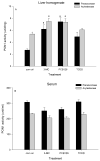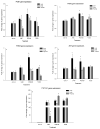Regulatory effects of dioxin-like and non-dioxin-like PCBs and other AhR ligands on the antioxidant enzymes paraoxonase 1/2/3
- PMID: 26006071
- PMCID: PMC4662644
- DOI: 10.1007/s11356-015-4722-1
Regulatory effects of dioxin-like and non-dioxin-like PCBs and other AhR ligands on the antioxidant enzymes paraoxonase 1/2/3
Abstract
Paraoxonase 1 (PON1), an antioxidant enzyme, is believed to play a critical role in many diseases, including cancer. PCBs are widespread environmental contaminants known to induce oxidative stress and cancer and to produce changes in gene expression of various pro-oxidant and antioxidant enzymes. Thus, it appeared of interest to explore whether PCBs may modulate the activity and/or gene expression of PON1 as well. In this study, we compared the effects of dioxin-like and non-dioxin-like PCBs and of various aryl hydrocarbon receptor (AhR) ligands on PON1 regulation and activity in male and female Sprague-Dawley rats. Our results demonstrate that (i) the non-dioxin-like PCB154, PCB155, and PCB184 significantly reduced liver and serum PON1 activities, but only in male rats; (ii) the non-dioxin-like PCB153, the most abundant PCB in many matrices, did not affect PON1 messenger RNA (mRNA) level in the liver but significantly decreased serum PON1 activity in male rats; (iii) PCB126, an AhR ligand and dioxin-like PCB, increased both PON1 activities and gene expression; and (iv) even though three tested AhR ligands induced CYP1A in several tissues to a similar extent, they displayed differential effects on the three PONs and AhR, i.e., PCB126 was an efficacious inducer of PON1, PON2, PON3, and AhR in the liver, while 3-methylcholantrene induced liver AhR and lung PON3, and 2,3,7,8-tetrachlorodibenzo-p-dioxin (TCDD), the most potent AhR agonist, increased only PON3 in the lung, at the doses and exposure times used in these studies. These results show that PCBs may have an effect on the antioxidant protection by paraoxonases in exposed populations and that regulation of gene expression through AhR is highly diverse.
Keywords: 3-MC; AhR; Non-dioxin-like PCB; PCB126; PON1; PON2; PON3; TCDD.
Conflict of interest statement
The authors declare no conflicts of interest.
Figures





Similar articles
-
Dietary antioxidants (selenium and N-acetylcysteine) modulate paraoxonase 1 (PON1) in PCB 126-exposed rats.Environ Sci Pollut Res Int. 2014 May;21(10):6384-99. doi: 10.1007/s11356-013-1690-1. Epub 2013 May 4. Environ Sci Pollut Res Int. 2014. PMID: 23644946 Free PMC article.
-
Toxicology and carcinogenesis studies of a binary mixture of 3,3',4,4',5-pentachlorobiphenyl (PCB 126) (Cas No. 57465-28-8) and 2,3',4,4',5-pentachlorobiphenyl (PCB 118) (Cas No. 31508-00-6) in female Harlan Sprague-Dawley rats (gavage studies).Natl Toxicol Program Tech Rep Ser. 2006 Nov;(531):1-218. Natl Toxicol Program Tech Rep Ser. 2006. PMID: 17342196
-
Regulation of paraoxonase 1 (PON1) in PCB 126-exposed male Sprague Dawley rats.Toxicol Lett. 2012 Mar 25;209(3):291-8. doi: 10.1016/j.toxlet.2012.01.003. Epub 2012 Jan 12. Toxicol Lett. 2012. PMID: 22266287 Free PMC article.
-
The paraoxonase 1, 2 and 3 in humans.Biochem Med (Zagreb). 2011;21(2):122-30. doi: 10.11613/bm.2011.020. Biochem Med (Zagreb). 2011. PMID: 22135851 Review.
-
Metals and Paraoxonases.Adv Neurobiol. 2017;18:85-111. doi: 10.1007/978-3-319-60189-2_5. Adv Neurobiol. 2017. PMID: 28889264 Review.
Cited by
-
Polychlorinated biphenyl 126 exposure in L6 myotubes alters glucose metabolism: a pilot study.Environ Sci Pollut Res Int. 2016 Apr;23(8):8133-40. doi: 10.1007/s11356-016-6348-3. Epub 2016 Mar 2. Environ Sci Pollut Res Int. 2016. PMID: 26936477
-
The Relationship between Cancer and Paraoxonase 1.Antioxidants (Basel). 2022 Mar 31;11(4):697. doi: 10.3390/antiox11040697. Antioxidants (Basel). 2022. PMID: 35453382 Free PMC article. Review.
-
Antioxidant Functions of the Aryl Hydrocarbon Receptor.Stem Cells Int. 2016;2016:7943495. doi: 10.1155/2016/7943495. Epub 2016 Oct 18. Stem Cells Int. 2016. PMID: 27829840 Free PMC article. Review.
-
The Aryl hydrocarbon receptor mediates reproductive toxicity of polychlorinated biphenyl congener 126 in rats.Toxicol Appl Pharmacol. 2021 Sep 1;426:115639. doi: 10.1016/j.taap.2021.115639. Epub 2021 Jul 10. Toxicol Appl Pharmacol. 2021. PMID: 34256052 Free PMC article.
References
-
- Aviram M, Rosenblat M, Billecke S, Erogul J, Sorenson R, Bisgaier CL, Newton RS, La Du B. Human serum paraoxonase (PON 1) is inactivated by oxidized low density lipoprotein and preserved by antioxidants. Free Radic Biol Med. 1999;26:892–904. - PubMed
-
- Aviram M, Rosenblat M. Paraoxonases (PON1, PON2, PON3) analyses in vitro and in vivo in relation to cardiovascular diseases. Methods Mol Biol. 2008;477:259–76. - PubMed
-
- Beltowski J, Jamroz-Wisniewska A, Borkowska E, Wojcicka G. Differential effect of antioxidant treatment on plasma and tissue paraoxonase activity in hyperleptinemic rats. Pharmacol Res. 2005;51:523–32. - PubMed
-
- bin Ali A, Zhang Q, Lim YK, Fang D, Retnam L, Lim SK. Expression of major HDL-associated antioxidant PON-1 is gender dependent and regulated during inflammation. Free Radic Biol Med. 2003;34:824–9. - PubMed
Publication types
MeSH terms
Substances
Grants and funding
LinkOut - more resources
Full Text Sources
Other Literature Sources
Medical
Miscellaneous

